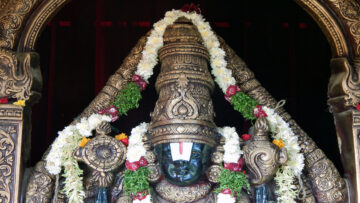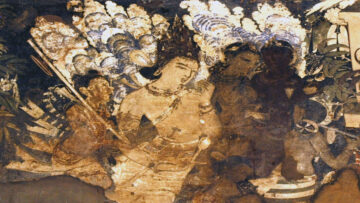[Note: This article is first in a series of three articles on rituals and mantras, based largely on the research of German Indologist Frits Staal. The first two articles are based solely on Staal’s research. The third part raises questions about how Vedic rituals lead to the insights found in the Upanishads and Vedanta, relying on the research of different scholars]
When my grandfather was a young man in his thirties, he used to go to a vathiyar (teacher) to learn suktams (hymns) from the Yajurveda. Coming from an orthodox Brahmin Iyer family, members of his jati and generation who learn Vedic rituals and mantras are usually pandits or purohits themselves, or were sent to pandits or purohits as children to learn mantras and rituals. It is unusual that my grandfather took this up in his thirties. He was a busy working man, with a wife and four children. And yet, something compelled him to take up learning the Yajurvedic suktams despite his busy schedule, and performing those rituals at home. Why he did so, I cannot say. But I can certainly relate to it, as can many Indians who ‘religiously’ do puja daily at home.
Many Indians experience peace of mind when they take part in and perform rituals. We intuitively feel that rituals are an essential part of our everyday lives. At the same time, when we are asked why we do it, and what is the point of rituals, we find ourselves groping for answers. We make up ad hoc explanations that are neither satisfying to us, nor to the questioner[1]. My father as a child used to ask my grandfather: Why do we perform these rituals? What is the purpose of rituals? One of the answers given by my grandfather was, we perform rituals because it is our family parambriya. The performance of the Yajurvedic rituals by my grandfather had a lineage which can be traced back to my grandfather’s grandfather, who taught the Yajurvedic suktams to his son and so on. This is quite a common answer given by many practitioners of ritual, when they are questioned about why they do it: “We do it because our ancestors did it”. In other words, a tradition is its own justification. We don’t need a separate reason or justification for practicing a ritual, other than the fact that what we’re following is a tradition. This answer also gives us some salient insights into the nature of ritual, as I show later in this essay.
Today, the so called millennial and ‘generation Z’ Indians experience a greater disconnect from rituals compared to the previous generations. Many of them criticize pujas and rituals as worthless activities. Superstitious relics from the past that have no value whatsoever in modern society. For example, some years back, a friend of mine who describes himself as an atheist, mocked a three hour homam that his parents were performing at home: ”What’s going to happen if they don’t do this three hour homam? Will Yama come and step on them?”. More recently, another friend of mine questioned and derided the Varalakshmi puja his mother was performing at home: ”What is the point of this? It is not as if the ceiling will open up and money will drop down once she finishes the puja”. In both of these examples, the implicit assumption is that these rituals are expressions of beliefs and desires; their parents are performing homa and puja, because they believe that deities like Yama or Lakshmi exist, and will help or harm them. Their parents also believe that performing these rituals will obtain them the objects they desire, such as money or good health. Whether or not rituals are expressions of intentional states (beliefs, desires, goals) is one of the important questions that this essay will address.
In the field of Humanities and Social Sciences unfortunately, very little research has been done on the nature and structure of rituals. Frits Staal is one of the few Indologists who has done extensive research and analysis on the structure of rituals, and its relationship to grammar.
This article is a summary of Staal’s research on rituals, and the insights that emerge from that research. The first part of this article is about the meaninglessness of ritual. The second part focuses on the rules that structure rituals. This part will also discuss the relationship between ritual and grammar, as well as Staal’s claim that Indian culture developed both a science of ritual and grammar. The third and final part of this essay tackles the question of the function of ritual in Indian culture. In particular, how do rituals contribute to human happiness?
In 1975, Frits Staal filmed and studied a massive two week Vedic ritual known as the Agnicayana ritual performed by a group of Nambudhiri Brahmins in southwest India. Staal rightly points out that the Vedic rituals remain the best source material to develop a theory of ritual, because they are the most elaborate and best documented rituals of humankind. The Srauta Sutras are one of the most detailed ritual manuals that contain the rules of performance of various Vedic rituals. One of the important observations made by Staal about rituals was that they are not activities that carry symbolic meaning.
An activity is meaningful if it embodies the intentions of the agent performing the activity. This includes the goals and beliefs of the agent, which the activity is an embodiment of. By contrast, Frits Staal claims that rituals are essentially meaningless, goalless activities.
(Figure 1: Preparing the Agnicayana altar)
It is important to note that the term ‘meaningless’ is not a value judgement on rituals. Staal is not claiming that rituals are worthless or useless. It is a technical term used by the scholar to build a hypothesis on the structure of rituals. An activity is meaningful if it embodies the intentions of the agent performing the activity. This includes the goals and beliefs of the agent, which the activity is an embodiment of. By contrast, Frits Staal claims that rituals are essentially meaningless, goalless activities.
The primary concern of the Brahmins performing the Vedic rituals is following the rules of the ritual. When Staal questioned the Brahmin ritualists as to why they perform the rituals, they got different answers: because it is our duty, because it is good for society, it leads to immortality. The most common answer given by the ritualists was the one my grandfather gave my father when he was asked why he was performing rituals: We perform rituals and act according to the rules because it is our parampara.
”Ritual, then, is primarily activity. It is an activity governed by explicit rules. The important thing is what you do, not what you think, believe or say. In India, this has become a basic feature of all religion, so that we should refer, not to the faithful or orthodox, but to the Greek orthoprax (from orthos, “right” and praxis, “action”).”[2]
If rituals are primarily activity, and not governed by beliefs or goals, and further, if this feature of pure activity is a basic feature of all Indian religion, then this has massive implications for the way we understand Indian culture as well as human psychology in general (since rituals are a widespread human phenomenon). This important claim about rituals, namely, its meaninglessness, is something that is directly contrary to how most intellectuals working in the fields of anthropology and religious studies conceptualize rituals.
Both Mirca Eliade and Jonathan Z Smith, two renowned scholars in the field of religious studies, thought of rituals as rich in symbolic meaning, enacting myths and embodying beliefs about the sacred.
A caveat is required at this point. It is true that people attribute all sorts of meaning to different rituals. For example, hinduwebsite.com describes puja as a ”represents the symbolic act of offering of our lives and activities to God which culminates with the Grace of God”[3]. The Gettysberg College of Pennsylvania website on Hinduism describes the goal of puja is to please God with all five senses[4]. However, the very fact that various meanings and goals can be attached to a ritual indicates that it is meaningless. Since it is pure ideal activity, ritual is like a tabula rasa to which different goals and meanings are ascribed. It is at this point, that many would object to the characterization of Indian rituals as goalless. After all, there are rites to fulfill specific desires: wealth, health, offspring etc. These rites appear to be clear counterexamples to the hypothesis that rituals are goalless. The school of Mimamsa, which deals with rituals, states that rituals are performed for a particular fruit or effect.
But Staal points to a seeming contradiction in the Mimamsa thought. The Srauta Sutras defines ritual as comprising of three things: ”dravya,” the substance (which is used in oblations)”; devata, “the deity (to which oblations are offered)”; and tyaga, “renunciation (of the fruits of the ritual acts)”[5]. On the one hand, the Mimamsa school says that a ritual is performed for a particular fruit, but on the other hand one renounces the fruit through the tyaga mantra. For example, in the Agnicayana ritual, the patron of the ritual utters the following tyaga mantra when offering oblations to the fire: ”this is for Agni, not for me” (agnayeidamna mama). Also, when the ritual is completed, the fruit is never seen. The Mimamsa philosophy states that the fruit is unseen and will become apparent later. The tyaga formula present in Vedic rituals is a strong piece of evidence that bolsters the hypothesis that rituals are goalless activities.
Another evidence used by Frits Staal to support his hypothesis of ritual meaninglessness is the fact that rituals and mantras are guarded very carefully. The past three thousand years in India have seen classical Sanskrit, and other Indian languages go through tremendous changes. During this period, Vedic mantras have remained changeless. Why? Because they are meaningless. Languages change because they are meaningful, and adapt to the times in order to remain functional. Meaningless activities and sounds can only be remembered or forgotten. Staal also speculates that ritual activities may have served a function at some time in the past, which they no longer serve now. He uses the example of the ceremony of Agnipranaya within the Agnicayana ritual. In a hymn known as the Apratiratha, Indra is invoked as a victorious hero in battle, and the officiating purohit recites: ”Comrades, follow in Indra’s footsteps”. Staal speculates that in times gone by, the Vedic people might have travelled through the Indian subcontinent from west to east, carrying fire with them, and occasionally having battles with other groups. The Apratiratha, which used to be a call to battle in older times, now becomes a mantra in the Agnipranya ceremony, no longer serving the function of a battle cry.
Another important insight in Frits Staal’s article on The Meaninglessness of Ritual (1979) is the contrast between ritual and everyday activities. In rituals, the rules of performance is what counts, not the result. In ordinary activity, the opposite holds true. An example of such an ordinary activity is going to the grocery store to buy vegetables. The steps and rules one follows in the execution of this activity, is much less important than the end goal, which is to buy vegetables. Having said that, the disadvantage of everyday activity is that there is no guarantee we will obtain the desired goal. The grocery shop may be closed. The vegetables we wish to purchase might be out of stock. Rituals on the other hand, are activities in which we are completely in control. We have established the rules ourselves, and the results don’t matter. If one step goes wrong or is interrupted, expiation rites take its place. This explains why rituals are readily engaged in. They have a peaceful, soothing effect. If you give up desire, you will be happy. This goes back to the notion of tyaga that was discussed earlier. The Bhagavad Gita considers tyaga as the highest form of activity. It seems that the meaninglessness of ritual also provides us a clue on the link between ritual and happiness.
To be continued…..
References:-
[1]Often these explanations take the form of the ritual having some deep spiritual significance (e.g. symbolizes our oneness with God, devotion to God), or some supposed scientific explanation. For example, some of my relatives claimed that certain homas and yagnas reduced the ph level of the groundwater in the location in which they are performed. It was good for the environment. And that is the reason our acharyas instituted them. These explanations aren’t satisfying and don’t mesh with our experience. It is doubtful that the acharyas who performed rituals knew about its supposed side effects on the environment. Moreover, those Indians who perform homas today don’t do so because of its effect on the environment.
[2]STAAL, Frits. The Meaninglessness of Ritual. Brill. 1979, Volume. 26, Issue. 1, p. 4.
[3]JAYARAM, V. The Symbolic Significance of Puja Or Worship In Hinduism. In: Hindu Website [online]. WebsiteURL: https://www.hinduwebsite.com/symbolisminpuja.asp
[4]What is Hinduism? In: Gettysburg College [online]. Website URL: https://www.gettysburg.edu/offices/religious-spiritual-life/world-religions-101/what-is-hinduism
[5]STAAL, Frits. The Meaninglessness of Ritual. Brill. 1979, Volume. 26, Issue. 1, p. 6.
Feature Image Credit: dreamstime.com
Disclaimer: The opinions expressed in this article belong to the author. Indic Today is neither responsible nor liable for the accuracy, completeness, suitability, or validity of any information in the article.












